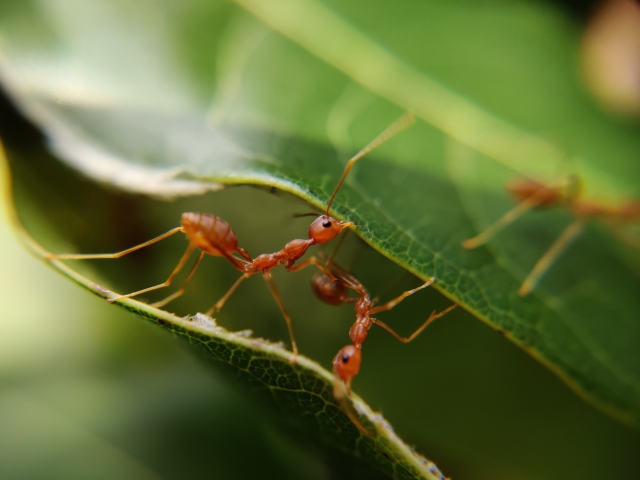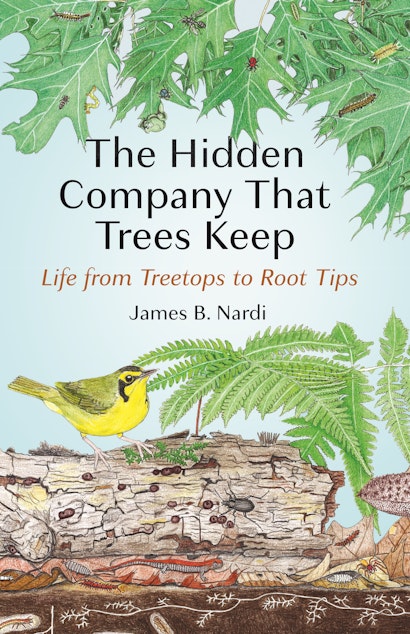You can tell a lot about a tree from the company it keeps. James Nardi guides you through the innermost unseen world that trees share with a wondrous array of creatures. With their elaborate immune responses, trees recruit a host of allies as predators and parasites to defend against uninvited advances from organisms that chew on leaves, drain sap, and bore into wood. Microbial life thrives in the hidden spaces of leaf scales, twigs, and bark, while birds, mammals, and insects benefit from the more visible resources trees provide. In return, animals help with pollination, seed dispersal, and recycling of nutrients. The Hidden Company That Trees Keep blends marvelous storytelling with beautiful illustrations and the latest science to reveal how the lives of trees are intertwined with those of their diverse companions.
Why call attention to these creatures hidden from view?
JN: Everyone loves trees and the many gifts they offer to humans and animals. Trees provide home, shelter, and food for familiar birds, mammals, and tree frogs. While these more conspicuous companions of trees are discussed and illustrated in this book, the invertebrate and microbial companions of trees occur in the greatest numbers and have by far the greatest influence on the lives of trees. They are the “little things that run the world”, but we often know so little about their lives. This book intends to rectify that oversight.
Only in recent years have researchers appreciated the importance of the innumerable microbial cells that support our human physiology and well-being. We are also discovering that other animals and plants share their bodies and lives with countless beneficent microbes. Microbes had previously been considered those creatures that are harmful and should be avoided.
At its birth from an acorn, a baby oak’s first action is to send down its root into the soil to take up its first mineral nutrients. Animal and microbial companions below ground feed the roots of trees by liberating nutrients from the plant litter that accumulates under each tree. Only after taking up its first nutrients does the seedling send forth its first shoot and leaves aboveground to soak up energy from the sun. All trees from the youngest to the oldest depend on nutrients from the soil and energy from the sun. Until its last days when it finally returns to the soil and its mineral nutrients are liberated for others to use, every tree depends on countless interactions with its hidden animal and microbial companions above ground and below ground. These companions of trees have served them well for eons. Loss of any of them may have disastrous consequences for trees.
What common language do trees and their companions share?
JN: Trees and their companions often share the same chemical language expressed by such simple plant hormones as cytokinins, salicylic acid, and ethylene. Fungi and bacteria of the soil establish their relationships with trees by responding to hormones secreted by tree roots.
Insect gall makers and probably their microbial partners as well stimulate the dividing cells of trees to form intricate and beautiful structures by careful release of plant hormones. What unfolds in the stimulated tree tissues are intricate arrangements of cells and tissues that the tree would never form if left to its own devices. These induced structures form around developing insects and mites and nourish them through their development until mature insects or mites set off to induce a new generation of plant galls.
Leaf-mining companions settle down in the narrow, confined two-dimensional space between the upper epidermis and lower epidermis of a tree’s leaf. Other companions artfully sculpt, fold, and roll planar leaves of trees into three-dimensional origami creations. Such structures created by the actions of these tree’s companions provide both their refuges and food. With help from their microbial partners, these manipulators of leaf forms prolong the life of their host leaves by releasing their own anti-senescence plant hormones.
What features of trees are inviting to their hidden companions and why do trees extend their invitations?
JN: All tissues of trees—from treetop to root tips—are colonized by bacteria and fungi. Trees are quite accommodating to their companions. Trees provide microscopic gateways to tree tissues in the form of leaf stomata and bark lenticels for these microbial colonists. Microbial companions not only provide nutrient benefits to their trees, but they apparently prime the tree’s immune response, strengthening the tree’s defenses against pathogenic microbes.
Trees provide welcoming homes, shelters, and food for the numerous creatures that pollinate their flowers, spread their seeds, and defend them from jaws of hungry insects. These include tree holes and nests for large colonizers with backbones as well as far tinier homes for colonizers without backbones that usually go unnoticed. The scanning electron microscope, however, has provided views of leaf and bark surfaces that an insect or a microbe would encounter. Specialized structures known as domatia or “little houses” are found on lower surfaces of many leaves. These tiny chambers or dense clumps of leaf hairs serve as refuges where both arthropod predators and prey can hide.
How can hidden companions act as allies for trees? How do trees effectively communicate with their allies?
JN: Our ancestors imagined a world of hidden companions and guardians associated with each tree. They referred to these allies of trees as their hamadryad (hama = together with; drya = tree) spirits.
In response to attack or injury, tree tissues injured by insects are often not only visibly apparent but also emit chemicals that attract companions that act as allies in defenses of trees against herbivores. Predators of all sizes—birds, frogs, mammals, and many insects—offer their assistance in defending trees. Tiny insect predators and parasites can translate the chemical alarm language of trees and are recruited to the sites of injury. Parasitic insects, although relatively tiny, make up a whopping 10 percent of all animal species—i.e., well over 160,000 species—and choose an equally diverse assortment of hosts. Parasitic insect larvae have adopted elaborate and ingenious tactics to overwhelm the immune defenses of their plant-feeding hosts, making them exceptional guardians and allies for trees. They come in otherworldly forms such as those of fairy wasps and pincer wasps and many lead very improbable lives, relying on chance encounters with just the right hosts.
How would you characterize this natural history book?
JN: This is not a standard field guide to a group of genetically related organisms. There are numerous guides to specific groups of creatures such as birds, beetles, flies, butterflies, fungi, and moths; but this is a guide to the multitude of different creatures from many different ancestral backgrounds that encounter one another on a tree and whose fates, and the fate of the tree, are intertwined.
The book integrates information about groups of organisms that typically are not considered together in standard field guides. In this book the one feature these creatures all have in common is their association with a particular habitat of a tree—its leaves, bark, roots, or wood. Each creature is considered in the context of its interactions with others sharing their habitat on a tree and shaping the dynamics of life on the tree.
A fact box lists the group’s common name, its scientific name, and the often-amusing Latin or Greek origin of the scientific name. To emphasize the exceptional diversity of so many of these groups, each fact box presents the number of species found worldwide as well as the number of species found in North America. Since new species are being discovered each year, the number of known and named species is always an underestimate of the true diversity.
The unfamiliar forms of representatives from each major group of creatures that resides on trees are illustrated with detailed drawings, some accompanied by images taken with a scanning electron microscope. These microscopic images offer an insect’s view of leaf and bark surfaces. The drawings capture many features not seen in photographs. Most people will never encounter many of these species at close range, so the illustrations offer views of a singular, alien world found on our neighborhood trees as well as trees of a forest.
What message do the companions of trees impart about our attempts to manage forests?
JN: Trees and their companions are mutually supportive. Trees endure and thrive in the company of innumerable animal and microbial companions. Even the creatures that consume leaves, roots, wood, or sap provide sustenance for other companions of trees. When they and other fellow companions settle to the earth, their remains are recycled by decomposers under the tree. Eventually the nutrients that all companions above ground and below ground borrowed from the tree return to the soil to nourish new generations of creatures. Trees and their companions coexist in such exquisite balance that human attempts to manage their lives often prove detrimental to both trees and the alliances they form with other creatures. By cherishing the great diversity of lives that keep trees company, we can preserve the intricate web of interactions that have been fine-tuned and perfected over the ages.
James B. Nardi is a research scientist in the School of Integrative Biology at the University of Illinois, Urbana-Champaign. His books include Life in the Soil: A Guide for Naturalists and Gardeners, Discoveries in the Garden, and Close Encounters with Insects and Spiders.

